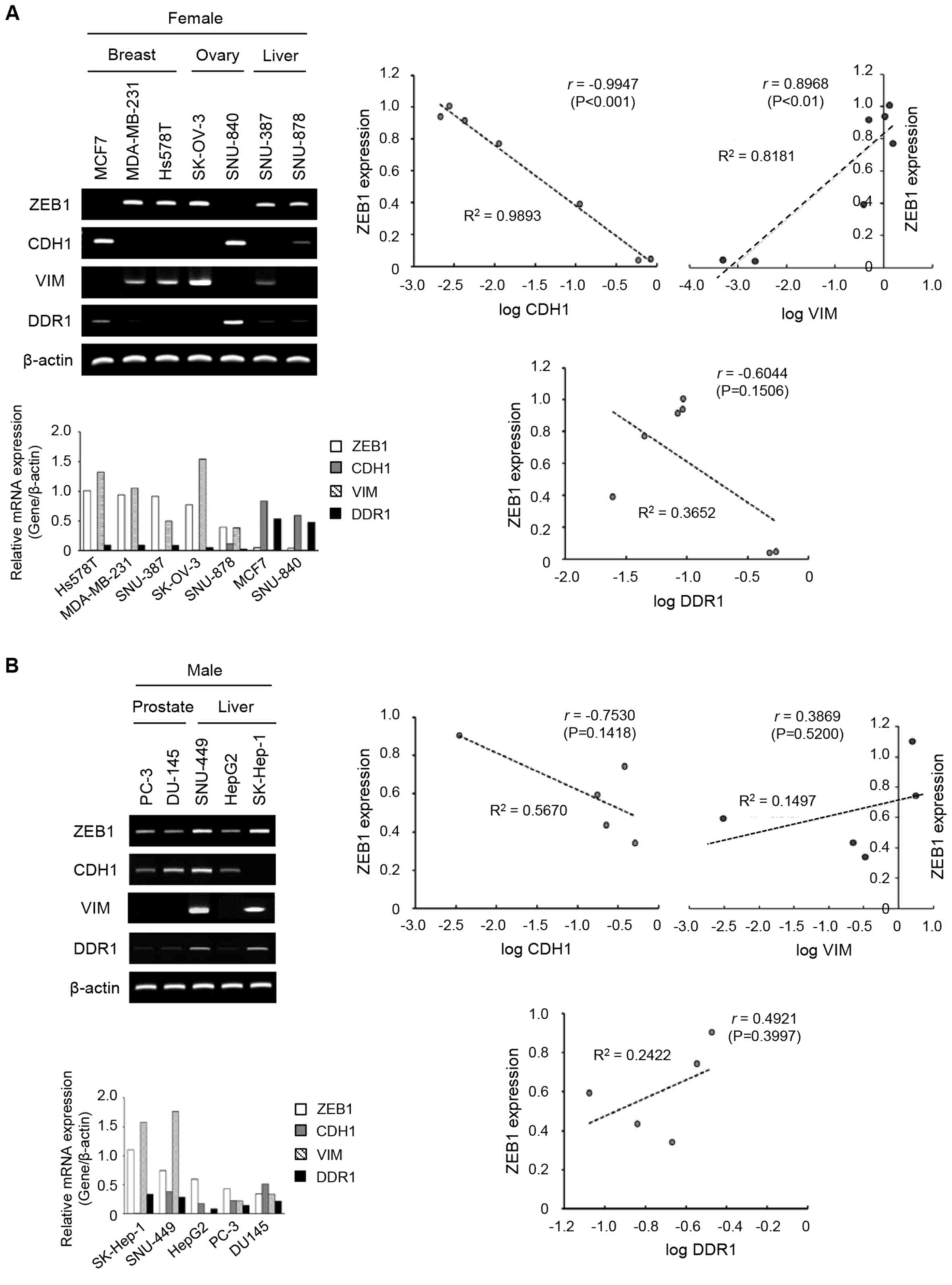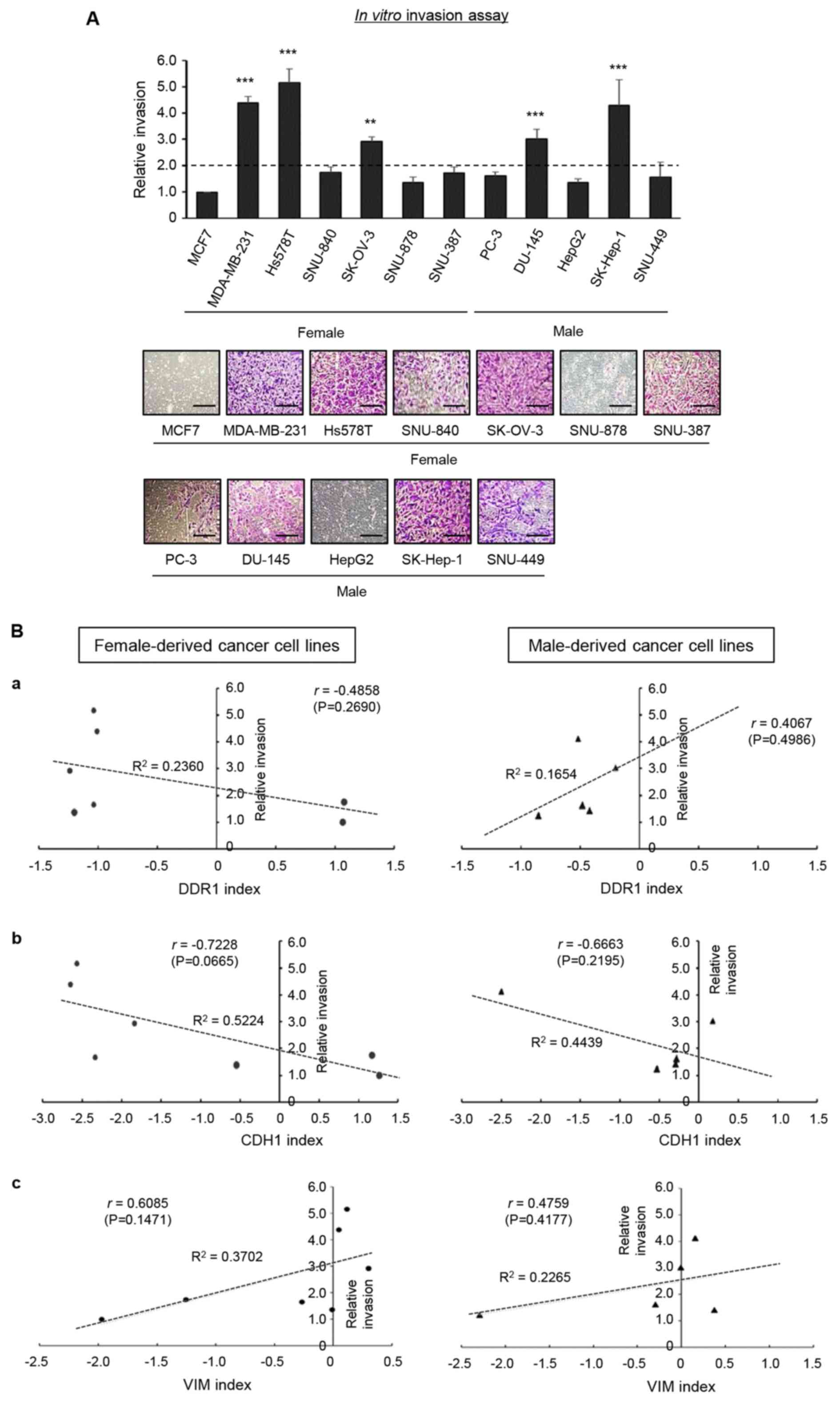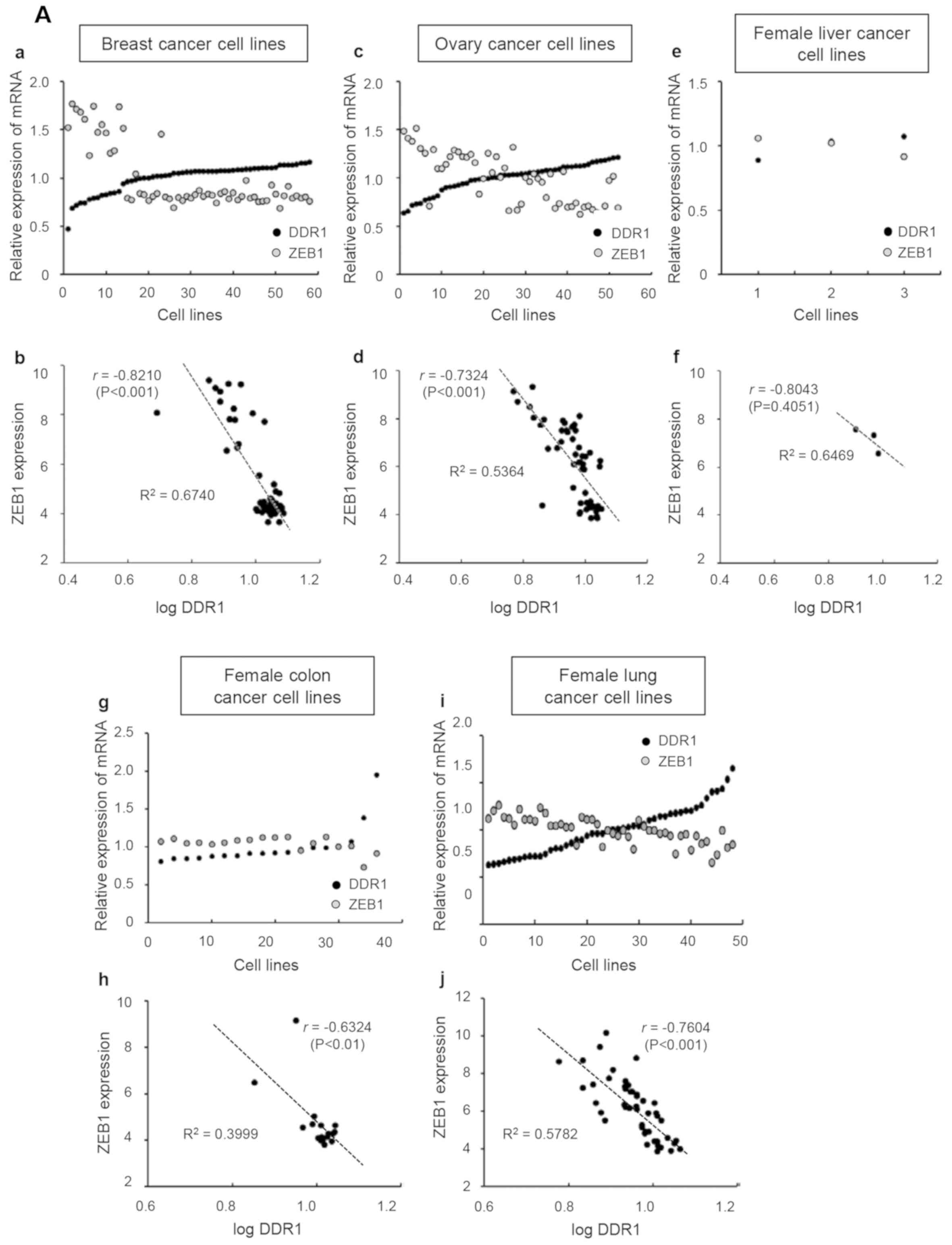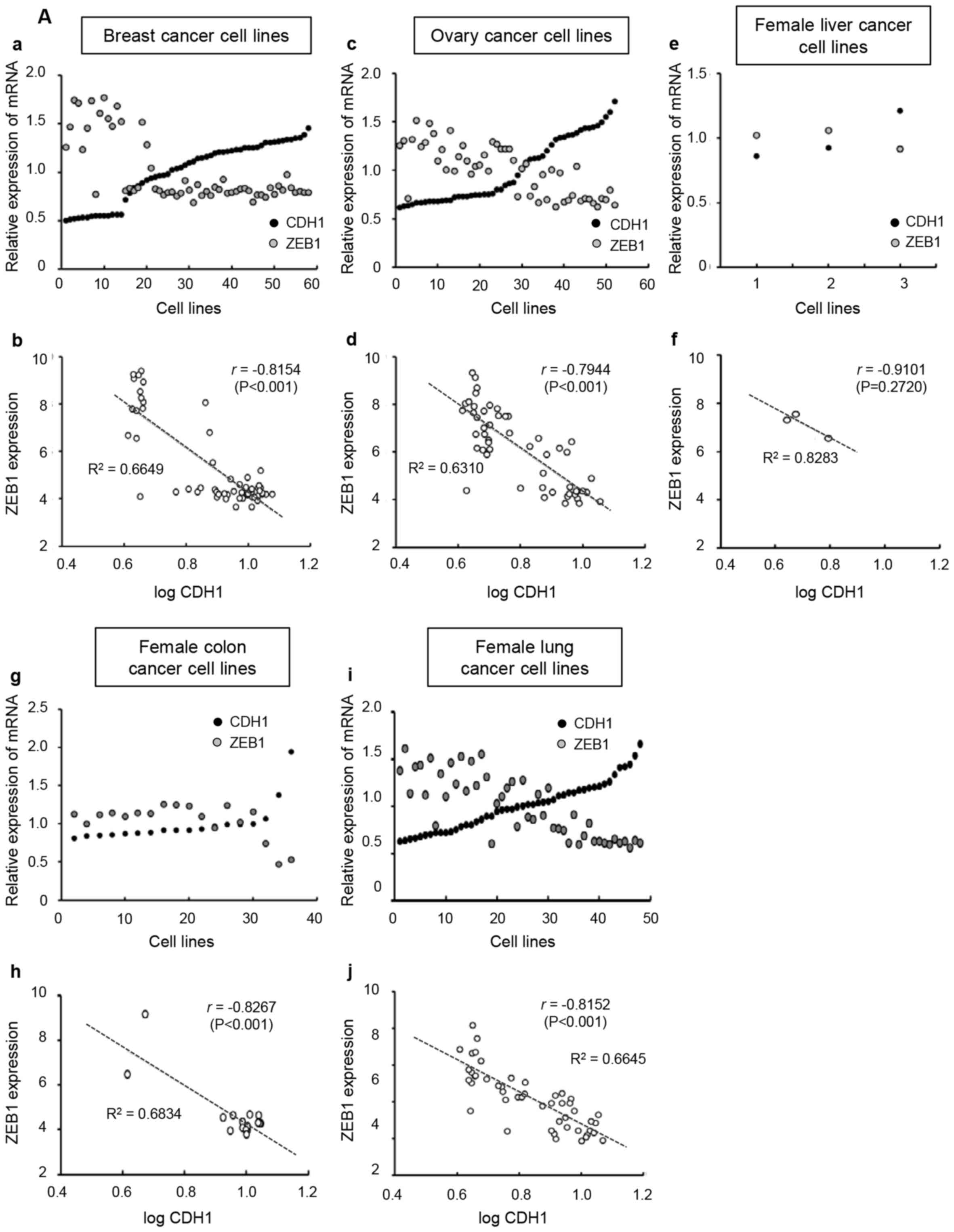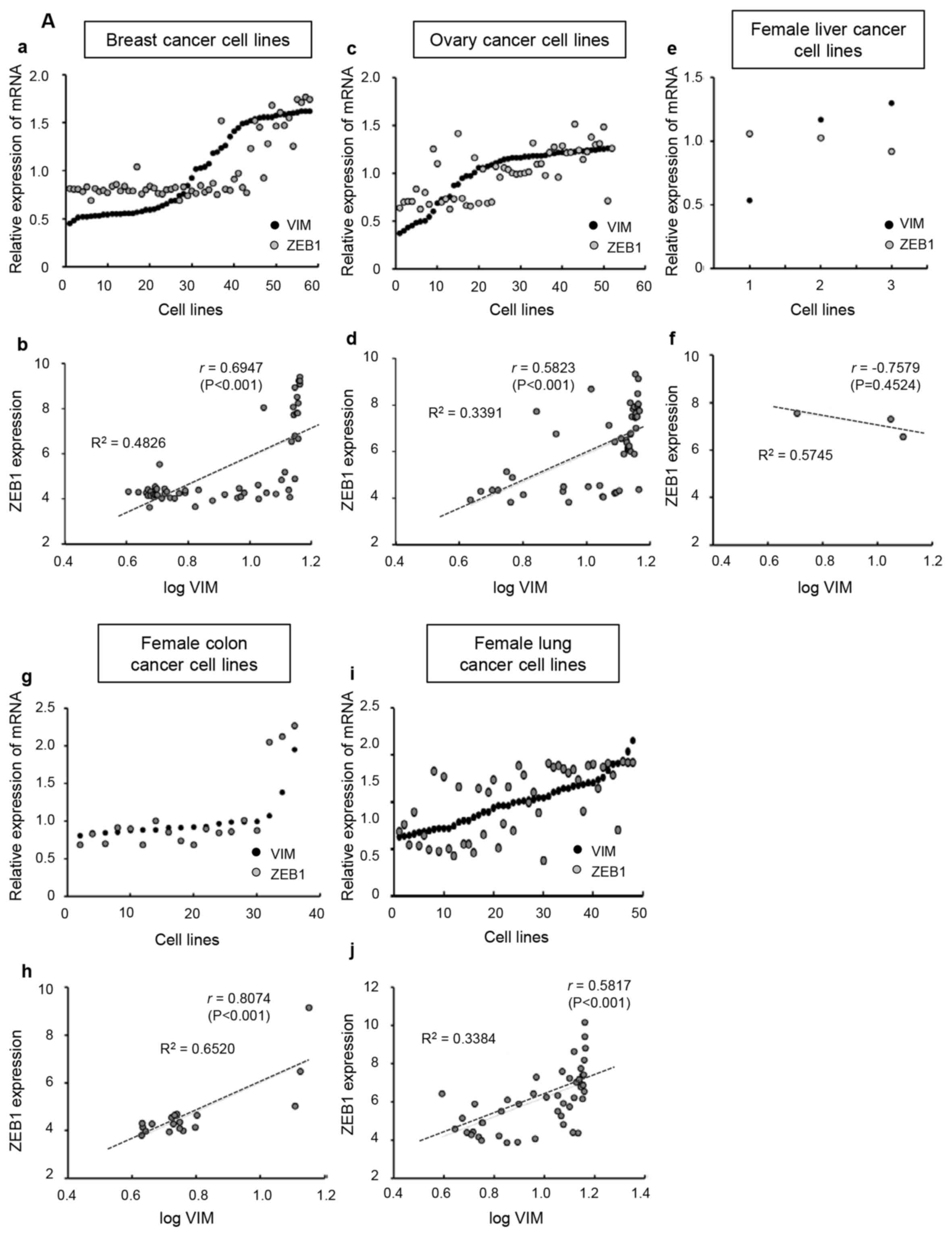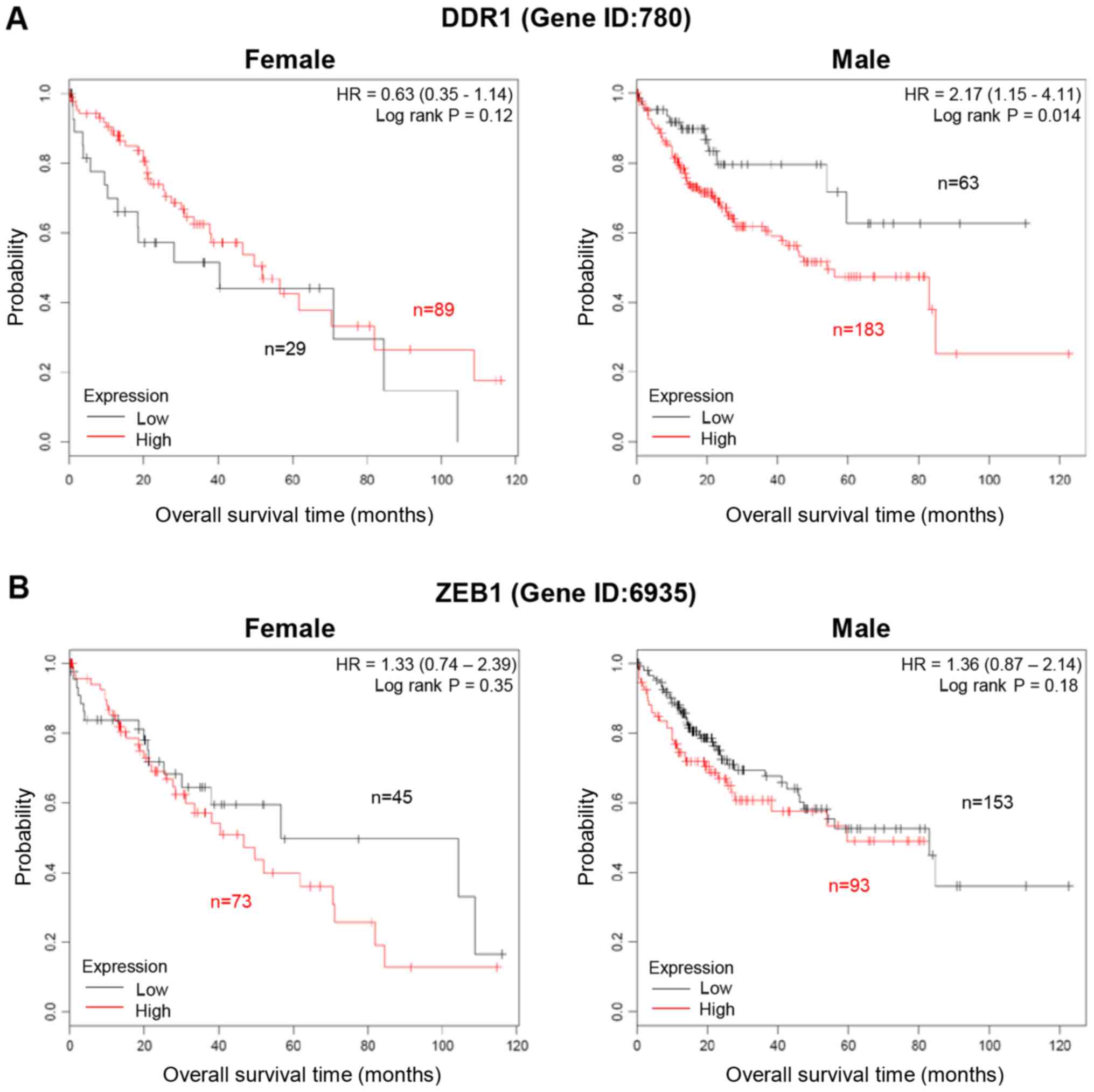|
1
|
Zahm SH and Fraumeni JF Jr: Racial,
ethnic, and gender variations in cancer risk: Considerations for
future epidemiologic research. Environ Health Perspect. 103 (Suppl
8):283–286. 1995. View
Article : Google Scholar : PubMed/NCBI
|
|
2
|
Kirsch-Volders M, Bonassi S, Herceg Z,
Hirvonen A, Möller L and Phillips DH: Gender-related differences in
response to mutagens and carcinogens. Mutagenesis. 25:213–221.
2010. View Article : Google Scholar : PubMed/NCBI
|
|
3
|
Dorak MT and Karpuzoglu E: Gender
differences in cancer susceptibility: An inadequately addressed
issue. Front Genet. 3:2682012. View Article : Google Scholar : PubMed/NCBI
|
|
4
|
Siegel RL, Miller KD and Jemal A: Cancer
Statistics, 2018. CA Cancer J Clin. 68:7–30. 2018. View Article : Google Scholar : PubMed/NCBI
|
|
5
|
Bosch FX, Ribes J, Díaz M and Cléries R:
Primary liver cancer: Worldwide incidence and trends.
Gastroenterology. 127:S5–S16. 2004. View Article : Google Scholar : PubMed/NCBI
|
|
6
|
Oh CM, Cho H, Won YJ, Kong HJ, Roh YH,
Jeong KH and Jung KW: Nationwide trends in the incidence of
melanoma and non-melanoma skin cancers from 1999 to 2014 in South
Korea. Cancer Res Treat. 50:729–737. 2018. View Article : Google Scholar : PubMed/NCBI
|
|
7
|
Bray F, Ferlay J, Soerjomataram I, Siegel
RL, Torre LA and Jemal A: Global cancer statistics 2018: GLOBOCAN
estimates of incidence and mortality worldwide for 36 cancers in
185 countries. CA Cancer J Clin. 68:394–424. 2018. View Article : Google Scholar : PubMed/NCBI
|
|
8
|
Jung KW, Won YJ, Kong HJ and Lee ES:
Prediction of cancer incidence and mortality in Korea, 2018. Cancer
Res Treat. 50:317–323. 2018. View Article : Google Scholar : PubMed/NCBI
|
|
9
|
Ryerson AB, Eheman CR, Altekruse SF, Ward
JW, Jemal A, Sherman RL, Henley SJ, Holtzman D, Lake A, Noone AM,
et al: Annual Report to the Nation on the Status of Cancer,
1975–2012, featuring the increasing incidence of liver cancer.
Cancer. 122:1312–1337. 2016. View Article : Google Scholar : PubMed/NCBI
|
|
10
|
Gao RN, Neutel CI and Wai E: Gender
differences in colorectal cancer incidence, mortality,
hospitalizations and surgical procedures in Canada. J Public Health
(Oxf). 30:194–201. 2008. View Article : Google Scholar : PubMed/NCBI
|
|
11
|
Thun MJ, Hannan LM, Adams-Campbell LL,
Boffetta P, Buring JE, Feskanich D, Flanders WD, Jee SH, Katanoda
K, Kolonel LN, et al: Lung cancer occurrence in never-smokers: An
analysis of 13 cohorts and 22 cancer registry studies. PLoS Med.
5:e1852008. View Article : Google Scholar : PubMed/NCBI
|
|
12
|
Cook MB, Dawsey SM, Freedman ND, Inskip
PD, Wichner SM, Quraishi SM, Devesa SS and McGlynn KA: Sex
disparities in cancer incidence by period and age. Cancer Epidemiol
Biomarkers Prev. 18:1174–1182. 2009. View Article : Google Scholar : PubMed/NCBI
|
|
13
|
Klein SL: The effects of hormones on sex
differences in infection: From genes to behavior. Neurosci Biobehav
Rev. 24:627–638. 2000. View Article : Google Scholar : PubMed/NCBI
|
|
14
|
Yuan Y, Liu L, Chen H, Wang Y, Xu Y, Mao
H, Li J, Mills GB, Shu Y, Li L and Liang H: Comprehensive
characterization of molecular differences in cancer between male
and female patients. Cancer Cell. 29:711–722. 2016. View Article : Google Scholar : PubMed/NCBI
|
|
15
|
Park MN, Park JH, Paik HY and Lee SK:
Insufficient sex description of cells supplied by commercial
vendors. Am J Physiol Cell Physiol. 308:C578–C580. 2015. View Article : Google Scholar : PubMed/NCBI
|
|
16
|
Becker JB, Arnold AP, Berkley KJ,
Blaustein JD, Eckel LA, Hampson E, Herman JP, Marts S, Sadee W,
Steiner M, et al: Strategies and methods for research on sex
differences in brain and behavior. Endocrinology. 146:1650–1673.
2005. View Article : Google Scholar : PubMed/NCBI
|
|
17
|
Keitt SK, Fagan TF and Marts SA:
Understanding sex differences in environmental health: A thought
leaders' roundtable. Environ Health Perspect. 112:604–609. 2004.
View Article : Google Scholar : PubMed/NCBI
|
|
18
|
Zucker I and Beery AK: Males still
dominate animal studies. Nature. 465:6902010. View Article : Google Scholar : PubMed/NCBI
|
|
19
|
Hay ED: An overview of
epithelio-mesenchymal transformation. Acta Anat (Basel). 154:8–20.
1995. View Article : Google Scholar : PubMed/NCBI
|
|
20
|
Kalluri R and Neilson EG:
Epithelial-mesenchymal transition and its implications for
fibrosis. J Clin Invest. 112:1776–1784. 2003. View Article : Google Scholar : PubMed/NCBI
|
|
21
|
Kalluri R and Weinberg RA: The basics of
epithelial-mesenchymal transition. J Clin Invest. 119:1420–1428.
2009. View Article : Google Scholar : PubMed/NCBI
|
|
22
|
Cano A, Pérez-Moreno MA, Rodrigo I,
Locascio A, Blanco MJ, del Barrio MG, Portillo F and Nieto MA: The
transcription factor snail controls epithelial-mesenchymal
transitions by repressing E-cadherin expression. Nat Cell Biol.
2:76–83. 2000. View Article : Google Scholar : PubMed/NCBI
|
|
23
|
Grooteclaes ML and Frisch SM: Evidence for
a function of CtBP in epithelial gene regulation and anoikis.
Oncogene. 19:3823–3828. 2000. View Article : Google Scholar : PubMed/NCBI
|
|
24
|
Comijn J, Berx G, Vermassen P, Verschueren
K, van Grunsven L, Bruyneel E, Mareel M, Huylebroeck D and van Roy
F: The two-handed E box binding zinc finger protein SIP1
downregulates E-cadherin and induces invasion. Mol Cell.
7:1267–1278. 2001. View Article : Google Scholar : PubMed/NCBI
|
|
25
|
Guaita S, Puig I, Franci C, Garrido M,
Dominguez D, Battle E, Sancho E, Dedhar S, De Herreros AG and
Baulida J: Snail induction of epithelial to mesenchymal transition
in tumor cells is accompanied by MUC1 repression and ZEB1
expression. J Biol Chem. 277:39209–39216. 2002. View Article : Google Scholar : PubMed/NCBI
|
|
26
|
Hajra KM, Chen DY and Fearon ER: The SLUG
zinc-finger protein represses E-cadherin in breast cancer. Cancer
Res. 62:1613–1618. 2002.PubMed/NCBI
|
|
27
|
Gilles C and Thompson EW: The epithelial
to mesenchymal transition and metastatic progression in carcinoma.
Breast J. 2:83–96. 1996. View Article : Google Scholar
|
|
28
|
Thompson EW, Newgreen DF and Tarin D:
Carcinoma invasion and metastasis: A role for
epithelial-mesenchymal transition? Cancer Res. 65:5991–5995,
discusion 5995. 2005. View Article : Google Scholar : PubMed/NCBI
|
|
29
|
Fu HL, Valiathan RR, Arkwright R, Sohail
A, Mihai C, Kumarasiri M, Mahasenan KV, Mobashery S, Huang P,
Agarwal G and Fridman R: Discoidin domain receptors: Unique
receptor tyrosine kinases in collagen-mediated signaling. J Biol
Chem. 288:7430–7437. 2013. View Article : Google Scholar : PubMed/NCBI
|
|
30
|
Valiathan RR, Marco M, Leitinger B, Kleer
CG and Fridman R: Discoidin domain receptor tyrosine kinases: New
players in cancer progression. Cancer Metastasis Rev. 31:295–321.
2012. View Article : Google Scholar : PubMed/NCBI
|
|
31
|
Wang CZ, Yeh YC and Tang MJ:
DDR1/E-cadherin complex regulates the activation of DDR1 and cell
spreading. Am J Physiol Cell Physiol. 297:C419–C429. 2009.
View Article : Google Scholar : PubMed/NCBI
|
|
32
|
Yeh YC, Wu CC, Wang YK and Tang MJ: DDR1
triggers epithelial cell differentiation by promoting cell adhesion
through stabilization of E-cadherin. Mol Biol Cell. 22:940–953.
2011. View Article : Google Scholar : PubMed/NCBI
|
|
33
|
Chung VY, Tan TZ, Huang RL, Lai HC and
Huang RY: Loss of discoidin domain receptor 1 (DDR1) via CpG
methylation during EMT in epithelial ovarian cancer. Gene.
635:9–15. 2017. View Article : Google Scholar : PubMed/NCBI
|
|
34
|
Song J, Chen X, Bai J, Liu Q, Li H, Xie J,
Jing H and Zheng J: Discoidin domain receptor 1 (DDR1), a promising
biomarker, induces epithelial to mesenchymal transition in renal
cancer cells. Tumour Biol. 37:11509–11521. 2016. View Article : Google Scholar : PubMed/NCBI
|
|
35
|
Koh M, Woo Y, Valiathan RR, Jung HY, Park
SY, Kim YN, Kim HR, Fridman R and Moon A: Discoidin domain receptor
1 is a novel transcriptional target of ZEB1 in breast epithelial
cells undergoing H-Ras-induced epithelial to mesenchymal
transition. Int J Cancer. 136:E508–E520. 2015. View Article : Google Scholar : PubMed/NCBI
|
|
36
|
Jeon YR, Kim SY, Lee EJ, Kim YN, Noh DY,
Park SY and Moon A: Identification of annexin II as a novel
secretory biomarker for breast cancer. Proteomics. 13:3145–3156.
2013. View Article : Google Scholar : PubMed/NCBI
|
|
37
|
Cha Y, Kang Y and Moon A: HER2 induces
expression of leptin in human breast epithelial cells. BMB Rep.
45:719–723. 2012. View Article : Google Scholar : PubMed/NCBI
|
|
38
|
Shin I, Kim S, Song H, Kim HR and Moon A:
H-Ras-specific activation of Rac-MKK3/6-p38 pathway: Its critical
role in invasion and migration of breast epithelial cells. J Biol
Chem. 280:14675–14683. 2005. View Article : Google Scholar : PubMed/NCBI
|
|
39
|
Kim MS, Lee EJ, Kim HR and Moon A: p38
kinase is a key signaling molecule for H-Ras-induced cell motility
and invasive phenotype in human breast epithelial cells. Cancer
Res. 63:5454–5461. 2003.PubMed/NCBI
|
|
40
|
Menyhárt O, Nagy Á and Győrffy B:
Determining consistent prognostic biomarkers of overall survival
and vascular invasion in hepatocellular carcinoma. Royal Soc Open
Sci. 5:1810062018. View Article : Google Scholar
|
|
41
|
Cancer Genome Atlas Research Network.
Electronic address, . simplewheeler@bcm.edu; Cancer
Genome Atlas Research Network: Comprehensive and integrative
genomic characterization of hepatocellular carcinoma. Cell.
169:1327.e23–1341.e23. 2017.
|
|
42
|
Gygi SP, Rochon Y, Franza BR and Aebersold
R: Correlation between protein and mRNA abundance in yeast. Mol
Cell Biol. 19:1720–1730. 1999. View Article : Google Scholar : PubMed/NCBI
|
|
43
|
Sommers CL, Byers SW, Thompson EW, Torri
JA and Gelmann EP: Differentiation state and invasiveness of human
breast cancer cell lines. Breast Cancer Res Treat. 31:325–335.
1994. View Article : Google Scholar : PubMed/NCBI
|
|
44
|
Arnold M, Sierra MS, Laversanne M,
Soerjomataram I, Jemal A and Bray F: Global patterns and trends in
colorectal cancer incidence and mortality. Gut. 66:683–691. 2017.
View Article : Google Scholar : PubMed/NCBI
|
|
45
|
Wong MCS, Lao XQ, Ho KF, Goggins WB and
Tse SLA: Incidence and mortality of lung cancer: Global trends and
association with socioeconomic status. Sci Rep. 7:143002017.
View Article : Google Scholar : PubMed/NCBI
|
|
46
|
Fidler IJ: Critical factors in the biology
of human cancer metastasis: Twenty-eighth G.H.A. Clowes memorial
award lecture. Cancer Res. 50:6130–6138. 1990.PubMed/NCBI
|
|
47
|
Vleminckx K, Vakaet L Jr, Mareel M, Fiers
W and Van Roy F: Genetic manipulation of E-cadherin expression by
epithelial tumor cells reveals an invasion suppressor role. Cell.
66:107–119. 1991. View Article : Google Scholar : PubMed/NCBI
|
|
48
|
Perl AK, Wilgenbus P, Dahl U, Semb H and
Christofori G: A causal role for E-cadherin in the transition from
adenoma to carcinoma. Nature. 392:190–193. 1998. View Article : Google Scholar : PubMed/NCBI
|
|
49
|
Spaderna S, Schmalhofer O, Wahlbuhl M,
Dimmler A, Bauer K, Sultan A, Hlubek F, Jung A, Strand D, Eger A,
et al: The transcriptional repressor ZEB1 promotes metastasis and
loss of cell polarity in cancer. Cancer Res. 68:537–544. 2008.
View Article : Google Scholar : PubMed/NCBI
|
|
50
|
Wizemenn TM and Pardue ML: Exploring the
biological contributions to human health:Does sex matter?
Washington DC: Natl Acad Press; 2001
|
|
51
|
Miller VM: In pursuit of scientific
excellence: Sex matters. Adv Physiol Educ. 36:83–84. 2012.
View Article : Google Scholar : PubMed/NCBI
|
|
52
|
Avery B, Jørgensen CB, Madison V and Greve
T: Morphological development and sex of bovine in vitro-fertilized
embryos. Mol Reprod Dev. 32:265–270. 1992. View Article : Google Scholar : PubMed/NCBI
|
|
53
|
Pergament E, Fiddler M, Cho N, Johnson D
and Holmgren WJ: Sexual differentiation and preimplantation cell
growth. Hum Reprod. 9:1730–1732. 1994. View Article : Google Scholar : PubMed/NCBI
|
|
54
|
Xu KP, Yadav BR, King WA and Betteridge
KJ: Sex-related differences in developmental rates of bovine
embryos produced and cultured in vitro. Mol Reprod Dev. 31:249–252.
1992. View Article : Google Scholar : PubMed/NCBI
|
|
55
|
Yang X, Schadt EE, Wang S, Wang H, Arnold
AP, Ingram-Drake L, Drake TA and Lusis AJ: Tissue-specific
expression and regulation of sexually dimorphic genes in mice.
Genome Res. 16:995–1004. 2006. View Article : Google Scholar : PubMed/NCBI
|
|
56
|
Shah K, McCormack CE and Bradbury NA: Do
you know the sex of your cells? Am J Physiol Cell Physiol.
306:C3–C18. 2014. View Article : Google Scholar : PubMed/NCBI
|
|
57
|
Ge H, Yan Y, Tian F, Wu D and Huang Y:
Prognostic value of estrogen receptor α and estrogen receptor β in
gastric cancer based on a meta-analysis and The Cancer Genome Atlas
(TCGA) datasets. Int J Surg. 53:24–31. 2018. View Article : Google Scholar : PubMed/NCBI
|
|
58
|
Huang X, Shu C, Chen L and Yao B: Impact
of sex, body mass index and initial pathologic diagnosis age on the
incidence and prognosis of different types of cancer. Oncol Rep.
40:1359–1369. 2018.PubMed/NCBI
|
|
59
|
Xu K, Cui J, Olman V, Yang Q, Puett D and
Xu Y: A comparative analysis of gene-expression data of multiple
cancer types. PLoS One. 5:e136962010. View Article : Google Scholar : PubMed/NCBI
|
|
60
|
Martinez-Ledesma E, Verhaak RG and Treviño
V: Identification of a multi-cancer gene expression biomarker for
cancer clinical outcomes using a network-based algorithm. Sci Rep.
23:119662015. View Article : Google Scholar
|















